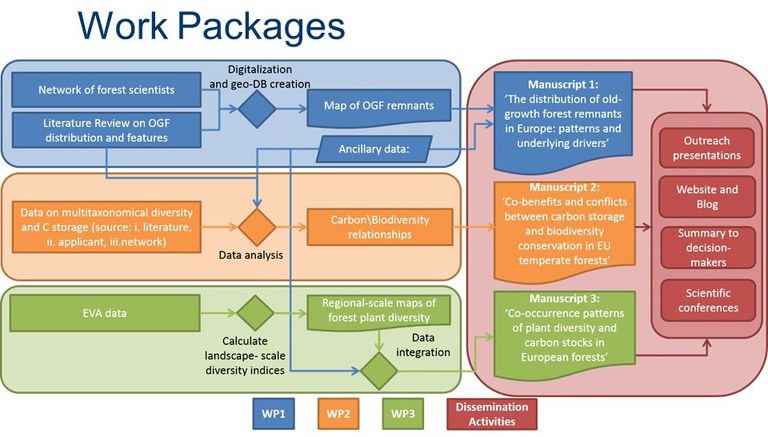FORESTS and CO - Project Overview
Background
Forests play a major role in the global carbon cycle, contain a substantial proportion of the world’s terrestrial biodiversity, and are valued for the services they provide to society1,2,3. Forest products alone are estimated at $120 billion annually2, although this estimation disregards the value of regulating, cultural and supporting services4. Importantly, forests are major carbon pools and play a critical role in mitigating climate change6, e.g., providing an estimated net global sink of 1.1 Pg C annually between 1990 and 20077. Forests also harbor the majority of the world’s biodiversity2.
Unfortunately, the rate of biodiversity loss is still alarmingly high and accelerates7,8, which is worrisome considering emerging close links between biodiversity, ecosystem functioning, and human well-being9.
A large body of evidence now suggests biodiversity loss affects the functioning of ecosystems10,11. Likewise, high species diversity is often associated with high productivity and ecosystem service (ES) provisioning, including carbon storage and sequestration11,12,13. Protecting forests and managing them sustainably is therefore important both to preserve biodiversity, and the services it underpins14. However, our ability to understand the consequences of biodiversity loss on the supply of a portfolio of multiple ES is still incomplete13.
Managing forests for multiple objectives requires a thorough scientific understanding of the trade-offs and synergies between the multiple contributions of forests to human wellbeing. Testing how carbon and biodiversity can be jointly maintained or enriched in forest landscapes is particularly important in this context, since it would allow forest-management strategies that jointly address climate change mitigation and biodiversity loss. This would also untap unrealized potentials to increase carbon and biodiversity gains in managed forests, or maximize the outcome of forest conservation and sustainable forest management (SFM) measures15.
To assess whether trade-offs or synergies occur between carbon and biodiversity in European forests, we will apply an interdisciplinary approach, bridging geography, forest ecology and remote sensing, and we will bring together a network of forest researchers working on European Forests.
Project Workplan
FORESTS and CO is composed by three work packages (WP) that will focus on both unmanaged, old-growth forests, representing a baseline for key ecosystem functions, and managed forest, constituting the majority of Europe’s forests (Fig. 1)
- WP1 will build a network of forest researchers to gather existing data on primary and old-growth forests in Europe, and create the first map of their distribution.
- WP2 will use plot-level data to model the relationship between forest biodiversity and carbon storage, and assess whether this relationship differs between old-growth and managed forests.
- WP3 will test whether carbon/biodiversity co-benefits vary, when scaled up to broader extents, using satellite products and vegetation-plot databases.

Cited References
- Parrotta JA, Wildburger C & Mansourian S (eds.) 2012. Understanding Relationships between Biodiversity, Carbon, Forests and People: The Key to Achieving REDD+ Objectives. A Global Assessment Report, Vienna: IUFRO World Series Volume 31.
- FAO 2010. Global Forest Resources Assessment 2010. Main report. FAO Forestry Paper. Rome: FAO.
- MEA 2005. Millennium Ecosystem Assessment. Ecosystems and Human Well-being: Synthesis, Washington, DC, Island Press.
- Costanza R, de Groot R, Sutton P, et al. 2014. Changes in the global value of ecosystem services. Global Environmental Change, 26, 152-158.
- Bonan GB 2008. Forests and Climate Change: Forcings, Feedbacks, and the Climate Benefits of Forests. Science, 320, 1444-1449.
- Pan YD, Birdsey RA, Fang JY, et al. 2011. A Large and Persistent Carbon Sink in the World's Forests. Science, 333, 988-993.
- Pimm SL, Jenkins CN, Abell R, et al. 2014. The biodiversity of species and their rates of extinction, distribution, and protection. Science, 344.
- Dirzo R, Young HS, Galetti M, et al. 2014. Defaunation in the Anthropocene. Science, 345, 401-406.
- Cardinale BJ, Duffy JE, Gonzalez A, et al. 2012. Biodiversity loss and its impact on humanity. Nature, 486, 59-67.
- Hooper DU, Chapin FS, Ewel JJ, et al. 2005. Effects of Biodiversity on Ecosystem Functioning: a Consensus of Current Knowledge. Ecol Monogr, 75, 3-35.
- Gamfeldt L, Snall T, Bagchi R, et al. 2013. Higher levels of multiple ecosystem services are found in forests with more tree species. Nat Commun, 4, 1340.xc
- Paquette A & Messier C 2011. The effect of biodiversity on tree productivity: from temperate to boreal forests. Glob Ecol Biogeogr, 20, 170-180.
- Balvanera P, Siddique I, Dee L, et al. 2014. Linking Biodiversity and Ecosystem Services: Current Uncertainties and the Necessary Next Steps. Bioscience, 64, 49-57.
- CBD 2002. Forest Biological Diversity – COP 6 decision VI/22. Available at: http://www.cbd.int/decision/cop/?id=7196.
- Strassburg BBN, Kelly A, Balmford A, et al. 2010. Global congruence of carbon storage and biodiversity in terrestrial ecosystems. Conservation Letters, 3, 98-105.


